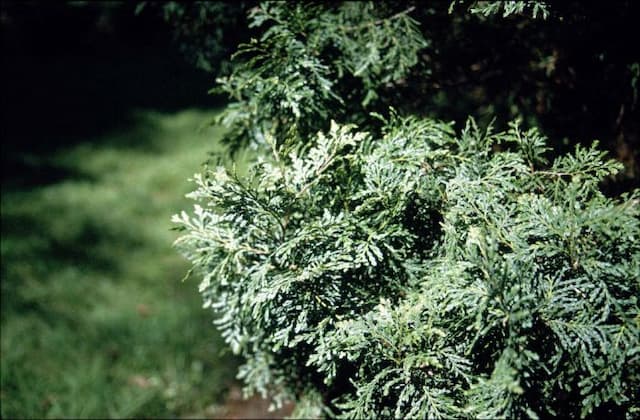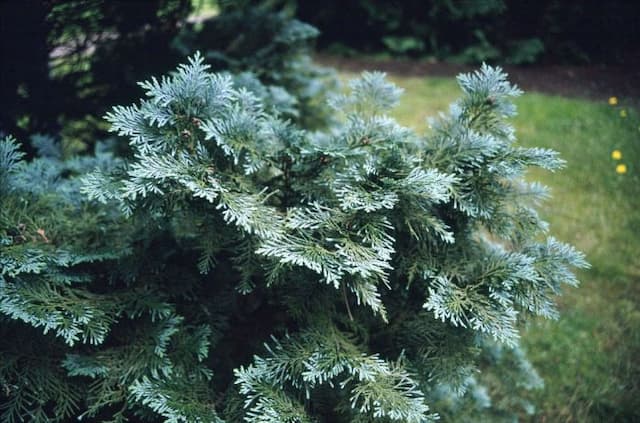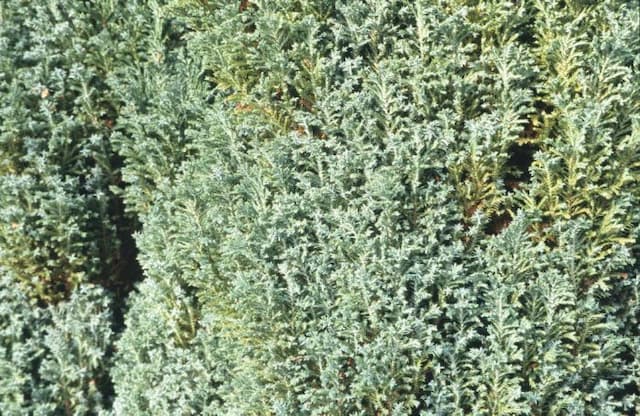Sumatran Pine Athrotaxis laxifolia

ABOUT
Athrotaxis laxifolia, commonly known as the Alpine Tasmanian cedar, is a coniferous plant with a distinct and attractive appearance. Its foliage is characterized by small, scale-like leaves that are arranged spirally around the branches, giving it a somewhat fluffy or soft texture. The leaves themselves are a lush green color, which contributes to the plant's overall verdant appearance. The branches of the Alpine Tasmanian cedar tend to spread outwards and can sometimes droop, giving the plant a slightly weeping profile. This species does not flower like many other plants; instead, it produces cones, which are the reproductive organs of conifers. The cones are relatively small and consist of numerous scales that are tightly packed together. Further contributing to its aesthetics, the bark of this plant has a fibrous texture and can range in color from a grayish hue to a reddish-brown. Over time, the bark may develop deep fissures, adding to the textural interest of the plant's appearance. The contrast between the bark and the foliage often makes the Alpine Tasmanian cedar a visually appealing specimen in its natural habitat. Overall, Alpine Tasmanian cedar has a unique and appealing aesthetic that is characterized by its soft, green foliage, drooping branches, and textured bark, making it a distinctive presence in the landscapes where it grows.
About this plant
 Names
NamesSynonyms
Tasmanian Cedar, Summit Cedar, Alpine Cedar, Pencil Pine.
Common names
Athrotaxis selaginoides var. laxifolia
 Toxicity
ToxicityTo humans
The Summit Cedar, scientifically known as Athrotaxis laxifolia, does not have any well-documented toxicity to humans. There is no widespread information available that suggests this particular species is poisonous if ingested. Nevertheless, it is generally advisable to avoid consuming parts of ornamental or wild plants due to the potential of unidentified toxins that could cause adverse reactions.
To pets
Similar to the information available for humans, there are no well-known toxic effects of the Summit Cedar or Athrotaxis laxifolia to pets. However, the lack of documented toxicity does not guarantee that the plant is safe for pets to consume. Many plants can cause digestive upset or other health issues in animals if ingested, so it is prudent to keep pets from eating this or any unknown plant material.
 Characteristics
CharacteristicsLife cycle
Perennials
Foliage type
Evergreen
Color of leaves
Green
Height
33 feet (10 meters)
Spread
20 feet (6 meters)
Plant type
Tree
Hardiness zones
7
Native area
Tasmania
Benefits
 General Benefits
General Benefits- Ecosystem support: Athrotaxis laxifolia, commonly known as the Tasmanian cedar, provides habitat and food for various wildlife species, including birds and insects.
- Ornamental value: Its unique foliage and conical shape make the Tasmanian cedar a desirable ornamental plant for landscaping and gardens.
- Soil stabilization: The root systems of Tasmanian cedar can help prevent soil erosion in sloped areas and contribute to slope stability.
- Climate resilience: Being native to Tasmania, Athrotaxis laxifolia is adapted to its local climate, making it resilient to the conditions within its natural range.
- Carbon sequestration: As a tree species, it absorbs carbon dioxide, thus playing a role in mitigating climate change by storing carbon in biomass.
- Education and Research: Tasmanian cedar can be used for educational purposes and scientific research, particularly in studying its ecology and conservation biology.
- Cultural significance: The plant may hold cultural importance for indigenous communities in Tasmania.
- Wood production: Though not a primary use, the wood of Tasmanian cedar is occasionally used for craftwork due to its fine texture.
 Medical Properties
Medical PropertiesThis plant is not used for medical purposes.
 Air-purifying Qualities
Air-purifying QualitiesThis plant is not specifically known for air purifying qualities.
 Other Uses
Other Uses- Athrotaxis laxifolia, commonly known as the Tasmanian cedar, can be used as an ornamental tree in gardens and parks for its conical shape and attractive foliage.
- Wood from the Tasmanian cedar is sometimes used in fine woodworking or for making musical instruments due to its tonal properties.
- The bark of the Tasmanian cedar can be used in tanning leather, providing a natural source of tannins.
- Because of its resistance to decay, the timber of the Tasmanian cedar can be used for outdoor applications such as decking, outdoor furniture, and fencing.
- The Tasmanian cedar's wood is used in the construction of specialty items like wooden model ships or intricate carving projects.
- The seeds of the Tasmanian cedar can be collected and sold as a specialty item for those interested in cultivating rare or endangered tree species.
- Dried foliage from the Tasmanian cedar can be used in decorative floral arrangements or as a natural addition to potpourri mixes.
- The dense foliage of the tree provides habitat and nesting sites for various species of birds and other wildlife.
- In forestry, the Tasmanian cedar can act as a nurse plant, providing shelter for more vulnerable species during reforestation projects.
- Fallen needles of the Tasmanian cedar can be used as a natural mulch in gardens, providing soil enrichment and weed suppression.
Interesting Facts
 Feng Shui
Feng ShuiThe Tasmanian cedar is not used in Feng Shui practice.
 Zodiac Sign Compitability
Zodiac Sign CompitabilityThe Tasmanian cedar is not used in astrology practice.
 Plant Symbolism
Plant Symbolism- Resilience – Athrotaxis laxifolia, commonly known as the Summit Cedar, is native to Tasmania where it grows in tough mountainous conditions, symbolizing the ability to withstand harsh environments and challenges.
- Endurance – The Summit Cedar can live for hundreds of years, representing long-lasting strength and the ability to endure over time.
- Rarity – This plant is not very common and grows in specific regions, which can symbolize uniqueness and the value of scarcity.
- Conservation – As a species that is considered vulnerable, the Summit Cedar stands as a symbol for conservation efforts and the importance of protecting natural habitats.
- Heritage – Being a plant with ancient lineage, it represents a connection to the past and the importance of heritage and history.
 Water
WaterThe common name for Athrotaxis laxifolia is the Tasmanian Cedar. When watering Tasmanian Cedar, it's important to keep the soil consistently moist but not waterlogged. During the growing season, watering once a week with approximately 2-3 gallons for an established plant is typically sufficient. However, the frequency should be adjusted depending on weather conditions; less water is required if it’s raining regularly, more if it's very dry or hot. Always check the soil moisture level a few inches down; if the soil at that depth feels dry, it's time to water again. It's critical not to let the soil dry out completely between watering sessions.
 Light
LightThe Tasmanian Cedar prefers a spot with full sunlight to partial shade. Best growth is achieved when the plant receives at least six hours of direct sunlight daily, but it will also tolerate light dappled shade, particularly in hotter climates. Avoid placing it in deep shade, as this can hinder growth and lead to a less vibrant plant.
 Temperature
TemperatureThe Tasmanian Cedar thrives in cool to moderate climates. It can withstand temperatures as low as 20 degrees Fahrenheit but is best suited to environments where temperatures don't typically drop below freezing. The optimum temperature range for this plant is between 60 and 70 degrees Fahrenheit. It may struggle in areas with prolonged hot temperatures over 80 degrees Fahrenheit.
 Pruning
PruningPruning the Tasmanian Cedar is done to maintain shape and remove any dead or diseased branches. It is best to prune during the dormancy period in late winter or early spring before new growth begins. This allows for better healing and less stress on the plant. Pruning should be performed as needed, typically every 2 to 3 years, to keep the appearance tidy and to promote a strong, healthy structure.
 Cleaning
CleaningAs needed
 Soil
SoilThe Tasmanian cedar (Athrotaxis laxifolia) thrives best in a well-drained, acidic soil with pH ranging from 5.5 to 6.5. A mix of peat, coarse sand, and loamy soil often provides the drainage and acidity needed for this plant's health.
 Repotting
RepottingThe Tasmanian cedar should be repotted every 2 to 3 years or when it has outgrown its current container. It's important to ensure minimal disturbance to the roots during the repotting process.
 Humidity & Misting
Humidity & MistingThe Tasmanian cedar prefers a moderate to high humidity level, ideally between 50-70%. It is tolerant of lower humidity but thrives in a more moist environment.
 Suitable locations
Suitable locationsIndoor
Ensure bright light, good humidity, and cool temps for Tasmanian cedar.
Outdoor
Plant in a shaded spot with moisture-retentive, acidic soil for Tasmanian cedar.
Hardiness zone
7-10 USDA
 Life cycle
Life cycleAthrotaxis laxifolia, commonly known as the Summit Cedar, begins its life cycle as a seed, released from mature female cones that have been pollinated by the male cones' wind-dispersed pollen. After germination, the seedlings develop into juvenile plants, characterized by rapid growth and the formation of a distinctive conical shape. As they mature into adulthood, the trees establish a sturdy trunk and develop scale-like leaves that contribute to their dense foliage. Adult Summit Cedars reach reproductive maturity and begin to produce their own cones, with the cycle of pollination and seed dispersal continuing. These trees can live for several centuries, during which they experience periods of growth and stasis, able to withstand various environmental conditions. Eventually, aging individuals go through senescence, leading to decreased vigor and, ultimately, death, whereupon they decompose and contribute to the forest ecosystem.
 Propogation
PropogationPropogation time
Spring-Early summer
The most popular method of propagating the Athrotaxis laxifolia, commonly known as the Tasmanian cedar, is through seed. Seed propagation typically commences in late winter to early spring when the risk of frost has passed. Mature cones should be collected from trees and then dried to facilitate the release of seeds. The seeds can then be sown in a well-draining seed starting mix, placed in a bright, warm location but not in direct sunlight. Consistent moisture is critical, so the soil should be kept lightly damp. Emerging seedlings are usually ready for potting on once they've developed a couple of true leaves. This process, while simple, can be slow and requires patience as germination may vary in time.









